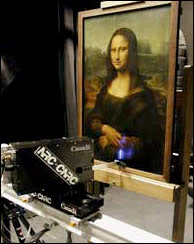
3-D Scan Illuminates Mona Lisa
The most important scientific study ever done of Leonardo da Vinci's portrait of the Mona Lisa has been completed, the National Research Council of Canada and the Centre de recherche et de restauration des musées de France (C2RMF), who collaborated on the study, announced today.
At the request of the C2RMF, researchers from the National Research Council of Canada (NRC) traveled to Paris to scan the 16th-century work painted on poplar wood titled "Mona Lisa," or "La Gioconda [La Joconde]" ) with a sophisticated laser scanner capable of capturing three-dimensional images at a depth resolution of 10 microns, about a tenth of the diameter of a human hair. The scanner has provided a number of unique views of the portrait that will help curators and conservators with their ongoing studies of the 500-year-old masterpiece, which hangs in the Musée du Louvre in Paris.

NRC scientist Marc Rioux examines the virtual 3-D model of the painting using a multiresolution display system also developed at NRC. (Photo: National Research Council Canada)
"The 3-D scan of the Mona Lisa has not only helped to further our understanding of Leonardo's sfumato technique of soft, heavily shaded modeling, but will also help to address the conservation and deterioration concerns we have," said Henri Loyrette, director of the Musée du Louvre, which commissioned the study. Some of the conclusions of the study include:
The wood panel on which the Mona Lisa is painted is sensitive to temperature and climate variations. However, if its current storage conditions are maintained, there is no risk of degradation.
The 12-cm split on the top half of the painting, which was probably due to the removal of the original frame and repaired between the middle of the 18th and 19th centuries, appears to be stable and has not worsened over time.
The very fine craquelure pattern recorded by the laser scanner seems to corroborate other inspection techniques and conclusions that support the principle of minimum intervention on the painting as recommended by the experts.

The 3-D high-resolution color laser scanner digitizing the Mona Lisa by Leonardo da Vinci. The laser scanner is mounted on a high-precision linear translation stage, which moves the scanner across the surface to acquire successive scan bands 4 cm in width (bluish line).(Photo: National Research Council Canada)
During the coming months, NRC will continue its research in collaboration with the C2RMF. Current studies focus on the very fine details of the paint layers and Leonardo's famous "sfumato" painting technique.
With the high-resolution of the NRC-IIT 3-D color laser scanning technology, the relief pattern of brush strokes on a typical painting appear like ripples on the sea.
"With the Mona Lisa, we don't see any signs of brush stroke detail," said the NRC Institute for Information Technology (NRC-ITT) scientist John Taylor, who coordinated the team's scientific examination of the Mona Lisa. "It's extremely thinly painted and extremely flat, and yet the details of the curls of hair, for example, are extremely distinct. So the technique is unlike anything we've ever seen before. Leonardo was in a league of his own."
Taylor said that although it is thought daVinci may have used his fingers to paint, there aren't any indications of fingerprints on the Mona Lisa -- as have been found on other da Vinci paintings. Art experts know that the sfumato technique involved overlaying translucent layers of color to create the perception of depth, volume, form and lighter or darker areas.
"With the scanning, we've demonstrated that the darker areas, such as the eyes, are indeed thicker, indicating that they are composed of a succession of thinly applied glaze layers," said François Blais, also an NRC-ITT scientist.
However, how the Renaissance master actually applied his layers of pigment and oil medium is still a mystery. Now the NRC-IIT team is working with commissioned replicas of sfumato on wood to better understand the interaction between the 3-D laser scanning and the material in the hope of one day cracking da Vinci's sfumato code.
The results of this study are published in Au coeur de la Joconde in French by Les Éditions Gallimard, and in Mona Lisa: Inside the Painting, published in English by Harry N. Abrams Inc. The German edition, which was released in May 2006, is titled Mona Lisa: Das große Buch zum berühmtesten Gemälde der Welt, published by Schirmer/Mosel.
Previously, NRC collaborated with Canadian and international museums to digitally record renowned works of art, such as Michelangelo's famous marble statue of David; paintings by Renoir, Corot and Thomson; and Bill Reid's Haida sculptures.
NRC's 3-D technology has a variety of other applications in the industrial, medical, space, forensic and entertainment sectors and has been licensed to several Canadian companies that have worked with Hollywood movie studios, NASA and car manufacturers such as Honda, Ford and Rolls Royce.
For more information, visit: www.nrc-cnrc.gc.ca
Published: September 2006